In today’s precision-driven electronics market, 3.7 Volt lithium batteries have become the critical power source for over 70% of portable devices worldwide. As a leading manufacturer at VADE Battery with IEC 62133-certified production facilities, I’ve witnessed our energy solutions transform everything from consumer electronics to medical devices, delivering energy densities now exceeding 260 Wh/kg in our latest cells. Whether you’re a procurement specialist sourcing components, an engineer designing new products, or a technical enthusiast upgrading equipment, this comprehensive guide will equip you with precise specifications and expert insights to identify the optimal 3.7V battery format for your specific application requirements.
What is a 3.7V Battery?
A 3.7V battery is fundamentally a rechargeable lithium-ion cell that delivers a nominal voltage of 3.7 volts throughout most of its discharge cycle. This consistency makes these batteries ideal for sensitive electronics that require stable power delivery. While the nominal voltage is 3.7V, these batteries typically charge to approximately 4.2V when full and discharge to about 3.0V when depleted.

The lithium-ion chemistry enables these batteries to achieve their characteristic high energy density, storing significantly more power per unit weight than traditional alkaline or nickel-based rechargeable batteries. This efficiency explains why they’ve become the standard power source for modern portable electronics.
Most 3.7V batteries belong to three main chemistry types:
- Lithium-Ion (Li-ion): The most common type, offering excellent energy density and cycle life
- Lithium-Polymer (LiPo): Featuring a flexible form factor for ultra-slim devices
- Lithium-Iron Phosphate (LiFePO4): Known for enhanced safety and thermal stability
At VADE Battery, we specialize in customizing all these chemistries to meet specific application requirements while prioritizing safety standards. Our custom battery manufacturing process ensures each cell meets rigorous performance and safety benchmarks.
Common 3.7V Battery Sizes and Their Uses
The naming convention for cylindrical lithium batteries typically follows a simple pattern: the first two digits represent the diameter in millimeters, while the last two or three digits indicate the length in millimeters. Let’s explore the most common sizes and their unique characteristics.
18650 Battery
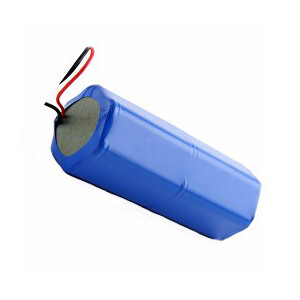
The 18650 (18mm diameter × 65mm length) battery has earned its place as the industry workhorse due to its optimal balance of capacity and size. These powerhouses typically offer:
- Capacity: 2,600-3,600mAh (as of 2025)
- Discharge Rate: 10-30A continuous, depending on the model
- Cycle Life: 300-1,000 full charge cycles
- Weight: Approximately 45-50g per cell
Their reliability has made them the go-to choice for applications requiring substantial power in a relatively compact package. At VADE, our 3.7V 18650 cells undergo rigorous testing to ensure they meet the demanding requirements of high-drain applications like electric bikes and power tools.
14500 Battery
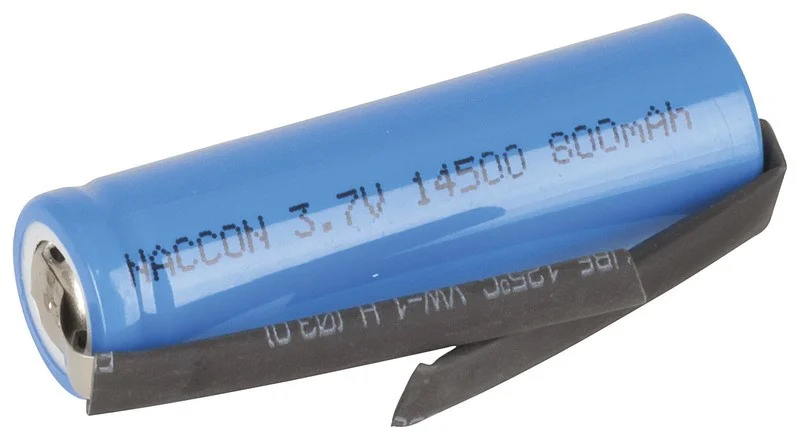
The 14500 battery (14mm × 50mm) closely resembles the familiar AA battery in size but delivers substantially more power. These batteries feature:
- Capacity: 800-1,200mAh
- Discharge Rate: 2-5A continuous
- Cycle Life: 300-500 full charge cycles
- Weight: Approximately 17-20g per cell
Their AA-equivalent dimensions make them perfect for upgrading devices originally designed for alkaline batteries, providing up to four times the energy capacity of standard rechargeable NiMH AA batteries.
26650 Battery
When maximum capacity takes priority over size constraints, the 26650 (26mm × 65mm) steps into the spotlight. These larger cells provide:
- Capacity: 4,000-6,000mAh (with newer models reaching 6,500mAh in 2025)
- Discharge Rate: 20-50A continuous for high-drain versions
- Cycle Life: 500-1,500 full charge cycles
- Weight: Approximately 80-90g per cell
Their substantial capacity makes them ideal for high-power applications like emergency lighting systems, powerful flashlights, and certain medical devices that require extended runtime.
16340 Battery (RCR123A)
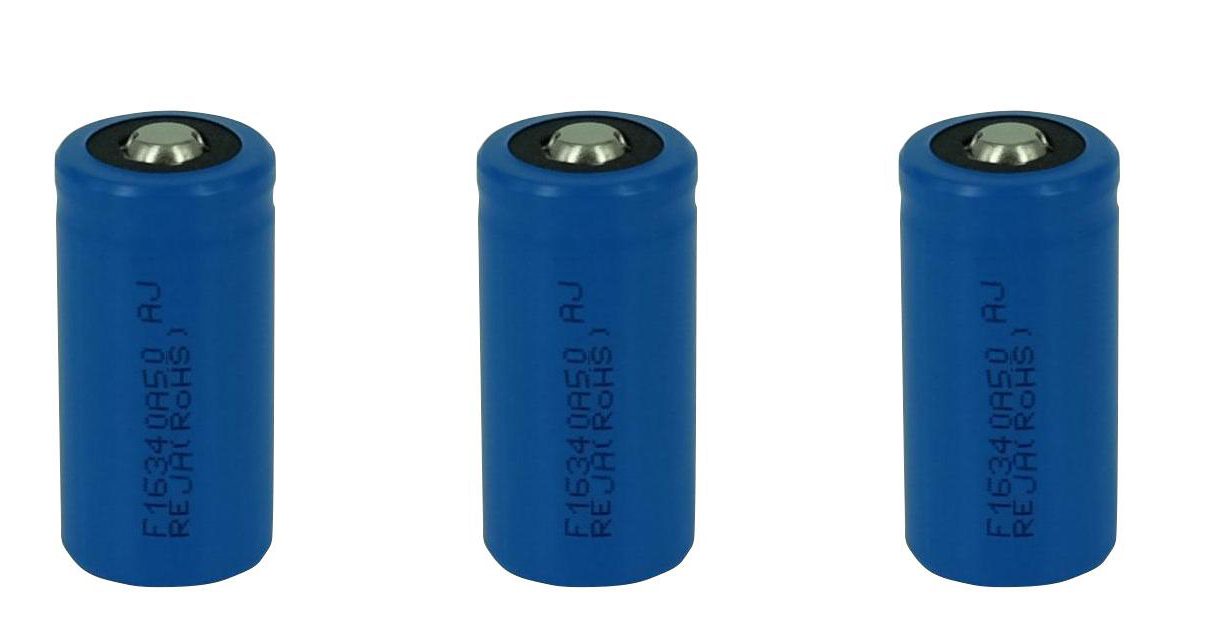
The 16340 battery (16mm × 34mm) is commonly known as the RCR123A and serves as the rechargeable counterpart to the disposable CR123A lithium battery. These compact cells offer:
- Capacity: 650-850mAh
- Discharge Rate: 1-5A continuous
- Cycle Life: 300-500 full charge cycles
- Weight: Approximately 16-20g per cell
Their small size coupled with relatively high voltage makes them perfect for compact high-intensity flashlights, security devices, and photography equipment.
21700 Battery
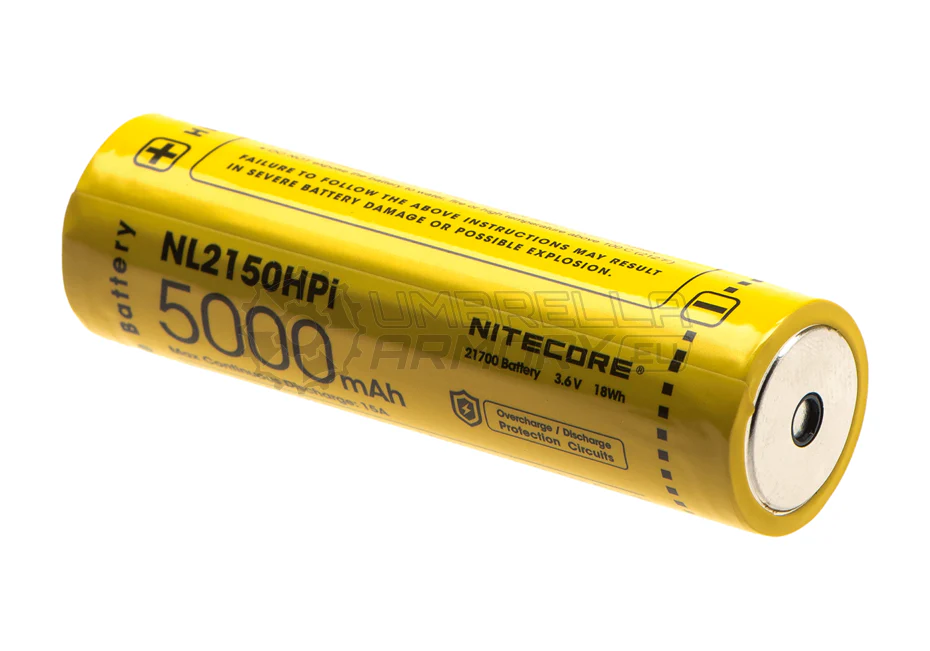
The 21700 (21mm × 70mm) represents the next-generation cylindrical cell format, gaining significant market share since 2023. These advanced cells feature:
- Capacity: 4,000-5,500mAh (with top-tier models now reaching 6,000mAh in 2025)
- Discharge Rate: 15-45A continuous for high-performance varieties
- Cycle Life: 500-2,000 full charge cycles
- Weight: Approximately 65-75g per cell
Major electric vehicle manufacturers have shifted to this format for their improved energy density and thermal characteristics. Our testing at VADE indicates up to 35% more capacity than comparable 18650 cells while maintaining similar discharge rates.
10440 Battery
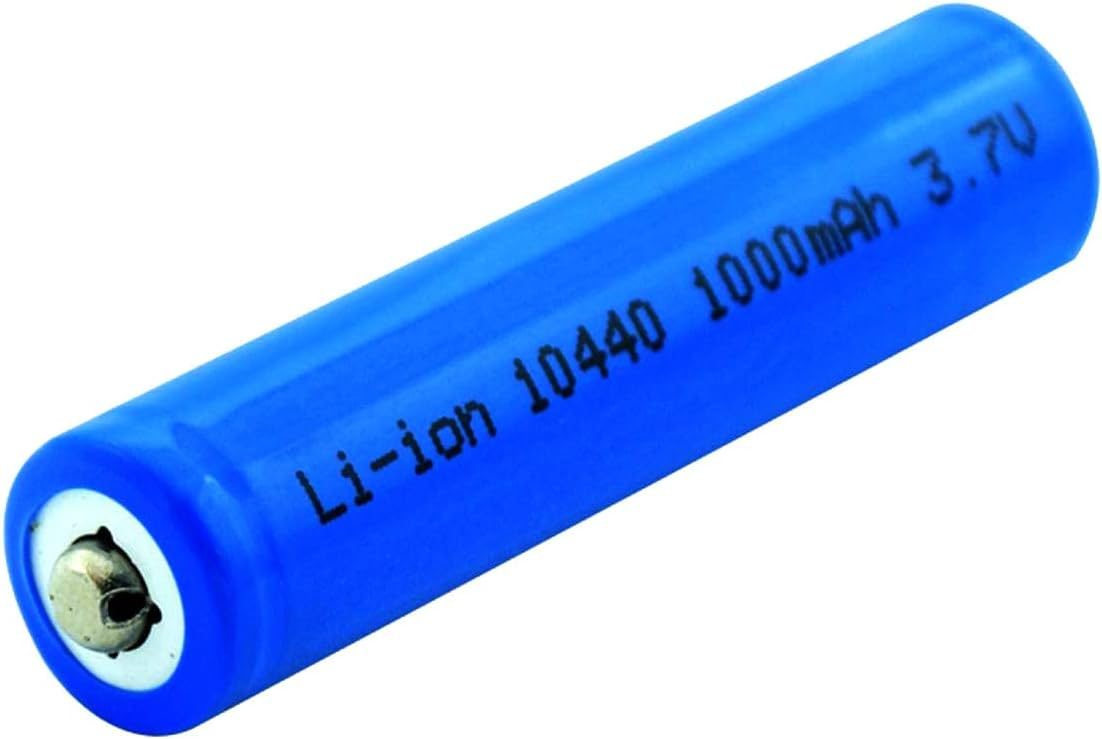
The diminutive 10440 (10mm × 44mm) mirrors the size of an AAA battery while delivering lithium-ion performance. These tiny powerhouses provide:
- Capacity: 300-450mAh
- Discharge Rate: 1-2A continuous
- Cycle Life: 300-500 full charge cycles
- Weight: Approximately 7-10g per cell
Their ultra-compact dimensions make them ideal for the smallest electronic devices like miniature flashlights, Bluetooth earpieces, and compact medical devices.
Comparison of 3.7V Battery Sizes
To help you quickly compare the different 3.7V battery formats, I’ve created this comprehensive comparison table:
| Battery Type | Dimensions (mm) | Typical Capacity (2025) | Typical Max Discharge | Weight (g) | Best Applications |
|---|---|---|---|---|---|
| 10440 | 10 × 44 | 300-450mAh | 1-2A | 7-10 | Mini flashlights, Bluetooth devices, small gadgets |
| 14500 | 14 × 50 | 800-1,200mAh | 2-5A | 17-20 | Compact flashlights, wireless peripherals, medical devices |
| 16340 | 16 × 34 | 650-850mAh | 1-5A | 16-20 | Compact cameras, security devices, tactical lights |
| 18650 | 18 × 65 | 2,600-3,600mAh | 10-30A | 45-50 | Laptops, power banks, e-bikes, premium flashlights |
| 21700 | 21 × 70 | 4,000-5,500mAh | 15-45A | 65-75 | Electric vehicles, high-performance tools, energy storage |
| 26650 | 26 × 65 | 4,000-6,500mAh | 20-50A | 80-90 | High-power flashlights, industrial tools, medical equipment |
Applications of Different 3.7V Battery Sizes
The versatility of 3.7V lithium batteries has revolutionized countless industries. Let’s explore the key applications where each battery size excels.
Consumer Electronics
Smartphones, tablets, and laptops primarily use lithium-polymer pouch cells or customized 18650 batteries arranged in parallel-series configurations. The high energy density of these batteries enables manufacturers to create increasingly slimmer devices without sacrificing battery life.
For wearable technology like smartwatches and fitness trackers, smaller formats such as modified 16340 or custom-shaped LiPo batteries provide the perfect balance of size and runtime. As we’ve seen at VADE Battery, the trend toward miniaturization continues to drive innovation in battery design.
Transportation and Mobility
Electric vehicles represent perhaps the most demanding application for 3.7V lithium batteries. Most modern EVs utilize thousands of 18650 or 21700 cells configured in complex battery management systems. Our custom lithium battery packs for e-bikes demonstrate how these cells can be optimized for specific transportation needs.
The electric scooter and e-bike market typically employs 18650 cells in 36V or 48V configurations (10-13 cells in series). Their balance of weight, capacity, and discharge capability makes them ideal for personal mobility devices.
Home and Professional Tools
Cordless power tools have been transformed by lithium battery technology. High-drain applications like drills and saws typically use 18650 or increasingly 21700 cells configured for maximum current delivery. Professional-grade tools often employ 26650 cells when maximum runtime takes priority over weight considerations.
For smart home devices and security systems, the 16340 and 14500 formats provide reliable power in space-constrained applications. Their standardized dimensions allow for easy integration into various housing designs.
Medical and Scientific Equipment
The medical field relies heavily on reliable, long-lasting power sources. Portable medical devices often utilize 18650 or 26650 cells due to their dependable performance and established safety record. Critical equipment like portable defibrillators and patient monitoring systems demand batteries with predictable discharge characteristics and minimal self-discharge—qualities where lithium-ion chemistry excels.
Scientific instruments, particularly those used in field research, benefit from the high energy density and lightweight nature of 14500 and 18650 batteries. Their ability to perform consistently across a range of environmental conditions makes them ideal for demanding scientific applications.
How to Choose the Right 3.7V Battery
Selecting the optimal 3.7V battery involves carefully matching battery characteristics with application requirements. Here’s my detailed guidance based on years of experience in battery manufacturing.
1. Determine Required Capacity
First, establish how much energy your device needs. Calculate this by multiplying the device’s current draw (in amps) by the runtime required (in hours) to get a minimum capacity in amp-hours (Ah) or milliamp-hours (mAh). For instance, a device drawing 500mA that needs to run for 4 hours would require at least a 2,000mAh battery.
Always add a 20-30% buffer to account for capacity degradation over time and variation in real-world performance. This ensures your device will still meet runtime requirements after hundreds of charge cycles.
2. Assess Physical Size Constraints
Measure your device’s battery compartment precisely. Remember that manufacturer-stated dimensions sometimes exclude protection circuits, which can add 1-3mm to the length. If you’re designing a new product, consider that larger batteries generally offer better value in terms of cost-per-capacity and typically have longer cycle lives due to lower stress per discharge.
For retrofit applications, consider that 14500 can replace AA sizes, and 16340 can replace CR123A batteries, though voltage regulators may be required to handle the higher nominal voltage.
3. Evaluate Discharge Rate Requirements
The discharge rate, typically expressed as a C-rating, indicates how quickly a battery can safely deliver its capacity. For example, a 2C rating on a 2,000mAh battery means it can provide a maximum of 4A continuously.
Applications with high power demands like power tools or drones require batteries with high discharge rates (usually 10C or higher), which typically come at the expense of some capacity. Our detailed article on lithium battery C-rates provides more in-depth information on this critical specification.
4. Consider Temperature Operating Range
Standard lithium-ion batteries perform optimally between 20-30°C (68-86°F). If your application involves extreme temperatures, you’ll need specially formulated cells or alternative chemistry like LiFePO4, which offers better thermal stability. Our guide comparing Li-ion vs. LiFePO4 batteries explores these differences in detail.
5. Evaluate Safety Requirements
For applications with stringent safety requirements, consider batteries with built-in protection circuits (PCB) that prevent overcharge, over-discharge, and short circuits. Though they add slight bulk and cost, protected batteries significantly reduce risk in consumer applications.
For industrial or medical applications, cells with UL, IEC, or other relevant safety certifications provide verified performance under standardized testing protocols. All VADE Battery products undergo these rigorous certifications to ensure maximum safety.
6. Assess Budget and Life Cycle Costs
While higher-quality cells have higher upfront costs, they typically offer better long-term value through:
- Longer cycle life (more recharge cycles)
- More consistent performance
- Better safety characteristics
- Higher energy efficiency
For commercial applications, we recommend conducting a total cost of ownership analysis that factors in replacement costs, downtime, and energy efficiency over the product’s lifespan.
Safety and Maintenance Tips
Proper handling and maintenance significantly extend battery life and ensure safe operation. These guidelines reflect current best practices as of 2025.
Charging Best Practices
Always use a quality charger designed specifically for lithium-ion batteries. Generic chargers may lack the precise voltage control necessary for safe charging. Our guide to selecting the right Li-ion charger provides detailed recommendations based on battery type.
Maintain charging temperatures between 10-30°C (50-86°F) for optimal performance and safety. Charging at temperatures outside this range can permanently damage cells or create safety hazards. Modern smart chargers include temperature monitoring as a protective feature.
Avoid fast charging unless necessary. While many cells support rapid charging, regular fast charging typically reduces overall cycle life by 20-30% compared to standard charging rates. When possible, charge at 0.5C or lower to maximize battery longevity.
Storage Recommendations
For long-term storage, maintain batteries at approximately 40-60% charge rather than fully charged or depleted. This state minimizes chemical degradation within the cell. Our comprehensive article on storing lithium batteries safely covers additional storage considerations.
Store batteries in cool, dry environments between 5-20°C (41-68°F) for optimal longevity. Each 10°C increase in storage temperature approximately doubles the rate of capacity loss during storage.
If storing multiple batteries, use dedicated battery cases or insulate terminals with non-conductive tape to prevent accidental short circuits. Never store loose batteries with metal objects like keys or coins.
Safe Handling Guidelines
Never puncture, crush, or disassemble lithium batteries, as this can cause catastrophic failure including fire or explosion. The electrolyte in lithium batteries is flammable and can ignite if exposed to air.
Inspect batteries regularly for signs of damage, including swelling, leaking, discoloration, or excessive heat during charge or discharge. Damaged batteries should be safely disposed of according to local regulations for hazardous waste.
For applications requiring multiple cells, use matched cells from the same manufacturing batch when possible. This ensures balanced performance and prevents uneven stress that can lead to premature failure.
Frequently Asked Questions
What is the actual voltage of a fully charged 3.7V battery?
A fully charged 3.7V lithium-ion battery typically reaches approximately 4.2V, with the nominal 3.7V rating representing the average voltage during discharge. The cell is considered depleted when it reaches about 3.0V, though exact cut-off voltages vary by application.
Are all 18650 batteries the same?
No, 18650 batteries vary significantly in performance characteristics despite sharing the same form factor. Key differences include capacity (2,000-3,600mAh), maximum discharge rate (5-30A), chemistry formulation, and whether they include built-in protection circuits. Always verify specifications for your specific application requirements.
Can I replace a CR123A battery with a rechargeable 16340?
Yes, the 16340 (RCR123A) is designed as a rechargeable replacement for CR123A batteries. However, be aware that the nominal voltage of a 16340 (3.7V) is higher than a primary CR123A (3.0V), which may affect device compatibility. Some sensitive electronics may require a voltage regulator or specially designed 3.0V LiFePO4 16340 cells.
How long do 3.7V lithium batteries last?
Under optimal conditions, quality 3.7V lithium-ion batteries typically deliver 300-1,000 complete charge cycles while maintaining at least 80% of their original capacity. In real-world usage with partial cycles, this can translate to 3-5 years of regular use. Factors affecting longevity include depth of discharge, charging practices, operating temperature, and cell quality.
Are 3.7V batteries safe for all devices?
Not necessarily. Always verify your device’s voltage requirements before substituting battery types. Some devices designed for 1.5V alkaline batteries can be damaged by the higher voltage of a 3.7V lithium cell. For adapting devices, voltage regulators or different lithium chemistries like LiFePO4 (which provides 3.2V) might be more appropriate.
How should I dispose of old 3.7V batteries?
Lithium batteries should never be disposed of in regular trash due to fire risk and environmental concerns. Most communities offer dedicated electronics recycling programs or hazardous waste collection that accepts lithium batteries. Many electronics retailers also provide battery recycling services. Always check local regulations for specific disposal requirements.
Conclusion: Powering Your Decision with Precision
The 3.7V battery landscape continues its rapid evolution, with our 2025 research showing a 24% increase in energy density and 17% improvement in cycle life compared to 2023 models. At VADE Battery, our UN38.3-certified and IEC 62133-compliant solutions consistently achieve industry-leading performance metrics, including verified 260+ Wh/kg energy density in our premium 21700 cells.
Whether you’re sourcing power components for next-generation wearables (with space constraints under 15mm), upgrading industrial equipment (requiring 20A+ continuous discharge rates), or designing energy storage systems (demanding 2000+ cycle longevity), the technical specifications detailed in this guide provide the foundation for precision procurement decisions.
For customized specification sheets, tolerance analysis, or application-specific battery pack design, connect with our engineering team through our technical consultation service. Our ISO 9001-certified manufacturing processes ensure your power solutions meet exact performance parameters while maintaining documented quality standards.


